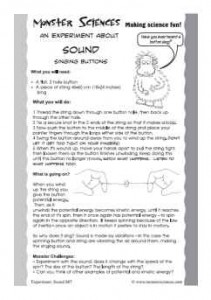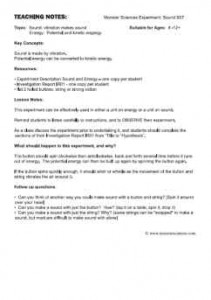Make a button sing in this experiment, during which students will learn about both sound and potential and kinetic energy.
 |
 |
An experiment about sound: The Singing Button
What you will need:
• A flat, 2 hole button
• A piece of string 45-60 cm (18-24 inches) long
What you will do:
1 Thread the string down through one button hole, then back up through the other hole.
2 Tie a secure knot in the 2 ends of the string so that it makes a loop.
3 Now push the button to the middle of the string and place your pointer fingers through the loops either side of the button.
4 Swing the button around away from you to wind up the string. don’t let it get too tight on your fingers!
5 When it’s wound up, move your hands apart to pull the string tight, then loosen them as the button finishes unwinding. Keep doing this until the button no longer moves. Watch what happens. Listen to what happens too!
What is going on?
When you wind up the string you give the button potential energy. Then, as it unwinds the potential energy becomes kinetic energy, until it reaches the end of it’s spin, then it once again has potential energy – to spin again in the opposite direction. It keeps spinning because of the law of inertia – once an object is in motion it prefers to stay in motion.
So why does it sing? Sound is made by vbrations – in this case the spinning button and string are vibrating the air around them, making the singing sound.
Monster Challenges:
• Experiment with the sound: does it change with the speed of the spin? The size of the button? The length of the string?
• Can you think of other examples of potential and kinetic energy?
TEACHING NOTES: Monster Sciences Experiment: Sound S07
Topic:
Sound: vibration makes sound
Energy: Potential and kinetic engergy
Key Concepts:
Sound is made by vibration.
Potential energy can be converted to kinetic energy.
Resources:
• Experiment Description Sound and Energy – one copy per student
• Investigation Report IR01 – one copy per student
• flat 2 holed buttons, string or strong cotton
Lesson Notes:
This experiment can be effectively used in either a unit on energy or a unit on sound.
Remind students to listen carefully to instructions, and to OBSERVE their experiment.
As a class discuss the experiment prior to undertaking it, and students should complete the sections of their Investigation Report IR01 from ”Title to “Hypothesis”.
What should happen in this experiment, and why?
The button should spin clockwise then anticlockwise, back and forth several time before it runs out of energy. The potential energy can then be built up again by spinning the button again.
If the button spins quickly enough, it should whirr or whistle as the movement of the button and string vibrates the air around it.
Follow up questions:
• Can you think of another way you could make sound with a button and string? [Spin it around over your head]
• Can you make a sound with just the button? How? [tap it on a table, spin it, drop it]
• Can you make a sound with just the string? Why? [some strings can be “snapped” to make a sound, but most are difficult to make sound with alone]
© www.monstersciences.com


